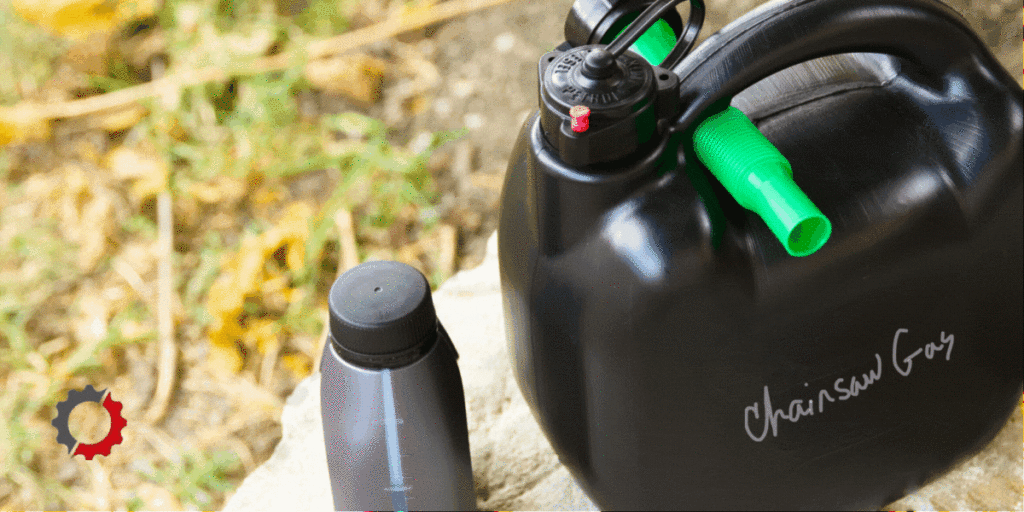You can’t just add any type of fuel to your chainsaw and expect it to run well and not do any damage. That’s why you must take extra care when choosing and caring for fuel in your chainsaw to keep it running at its best.
With so many types of fuels offered at fuel stations today, it can be confusing knowing the right gas to use in a chainsaw. Most chainsaws being used today have a 2-cycle engine which requires gas to be mixed with premium 2-cycle engine oil.
A few things to keep in mind when storing fuel are to keep it away from moisture and the outdoor elements; store it in a cool dry place, and consume it within 30 days. Always work in a well-ventilated area.

This post may include affiliate links. Purchases made through these links may provide a commission for us, at no extra cost to you. As an Amazon Associate, we earn from qualifying purchases.
Follow all safety instructions provided in your equipment operator’s manual prior to diagnosing, repairing, or operating.Consult a professional if you don’t have the skills, or knowledge or are not in the condition to perform the repair safely.
Don’t Let Old Gas Sit in a Chainsaw
One of the biggest things to manage when operating a chainsaw to minimize problems is the fuel. Old fuel sitting in a chainsaw can attract moisture to the fuel system and leave behind varnish and gummy deposits.
This can clog the fuel system and cause parts failures that may cause starting and running problems. Using old fuel can cause the engine to run sluggishly. It may feel like the chainsaw is just not giving you the power it should.
Gas begins to break down quickly. Because of this, it’s best to consume fuel within 30 days after purchase. A fuel additive like Sea Foam Motor Treatment can be added to stabilize the gas to make it last a little longer.
Some oils already include a stabilizer. Don’t assume, just because a stabilizer is included, that the fuel with stay good for a long period. Some oils with added fuel stabilizers will keep fuel fresh for up to 30 days while others state up to 2 years.
Chainsaws require unleaded gasoline with a minimum octane rating of 89 (mid-grade) and maximum ethanol content of 10% (E10). Never use E15, E30, or E85 in the engine as this will damage the engine and most likely void manufacturer warranties.
If you are running a 2-cycle engine on your chainsaw, you must mix it with premium 2-cycle engine oil.
Many manufacturers will not warranty replace carburetors after 30-90 days of purchase because of the effects fuel can have on a chainsaw. Using the wrong type of fuel or running bad fuel through your chainsaw is not a manufacturer defect.
Ethanol-free fuels are always best to run in your chainsaw, but it is a more expensive fuel choice.
Ethanol-Free Fuels for Chainsaws
- 2-Cycle 50:1 Premix
- 2-Cycle 40:1 Premix
- 4-Cycle Fuel
Gas and Oil to Use in a 2-Cycle Chainsaw
2-Cycle Gas and Oil Mix for a Chainsaw
The last thing you want to do is add the wrong fuel to a chainsaw. If you accidentally add straight gas to a 2-cycle chainsaw, it can seize and permanently damage the engine.
Without oil added to gasoline, the engine will not get the lubrication it needs for its internal parts to move freely.
A 2-cycle engine in a chainsaw uses gas and oil mixed at a ratio of 50:1, 40:1 depending on the manufacturer. You can find the correct ratio in your operator’s manual and possibly on an original fuel cap.
When creating this fuel mix, use unleaded gasoline with a minimum octane rating of 89 (mid-grade) and maximum ethanol content of 10%. Add a 2-cycle premium engine oil that is ISO-L-EGD and JASO M345 FD certified. DO NOT use regular automotive engine oil.
Here are common chainsaw manufacturers along with their CURRENT required fuel-to-oil mix ratio:
| Manufacture | Gas to Oil Mix | 2-Cycle Oil | Premixed Fuel |
|---|---|---|---|
| ECHO | 50:1 | Echo | Red Armor Pre-Mix |
| Husqvarna | 50:1 | Husqvarna | XP Pre-Mix |
| Poulan Pro | 50:1 | Poulan Pro | |
| Remington | 40:1 | ||
| Ryobi | 50:1 | Ryobi | |
| Stihl | 50:1 | Stihl | Moto Mix Pre-Mix |
How to mix gas and oil for a 2-cycle chainsaw:
- Use the chart below to determine how much fuel mix to prepare.
- Remove the cap from an approved gas can. Add unleaded fuel (minimum 89 octane rating & maximum 10% ethanol content) to a gas can.
- Use the chart for ounces of oil required for the amount of fuel you placed in the can. Add the 2-cycle oil to the gas can.
- Replace the cap.
- Gently shake the fuel and oil until they are mixed.
- Add to the chainsaw’s fuel tank.
You can use the manufacturer’s 2-cycle oil. Another alternative is this 2-cycle mix by Kawasaki. It comes in 5.2 oz. and 6.4 oz. bottles that can be mixed with 2 gal. or 2.5 gal. of gas respectively for a 50:1 mix. Use 2 gal. of gas and a 6.4 oz bottle of oil to achieve a 40:1 mix.
2-Cycle Gas to Oil Mix Ratio
| Gas to Oil Mix | 1 Gallon | 2 Gallon | 2.5 Gallon |
|---|---|---|---|
| 50:1 | 2.6 oz | 5.2 oz | 6.4 oz |
| 40:1 | 3.2 oz | 6.4 oz | 8.0 oz |
| 32:1 | 4.0 oz | 8.0 oz | 10.0 oz |
2-Cycle Premixed Fuel
Because of the negative effects of ethanol, a great option to avoid ethanol is using a premixed fuel. Many manufacturers offer an ethanol-free premixed fuel that is ready to pour into the fuel tank.
This is a convenient option to have sitting on the shelf so you don’t have to make last-minute trips to the gas station and deal with mixing fuel.
A great option to reduce fuel problems and extend engine life is using an ethanol-free fuel mix. Many manufacturers offer their own brand of premixed fuels.
You can also use this 40:1 premixed fuel or 50:1 premixed fuel by TruFuel. This is an ethanol-free blend of oil and fuel that is ready to pour into your chainsaw’s fuel tank.
Gas and Oil to Use in a 4-Cycle Chainsaw
Gas for a 4-Cycle Chainsaw
Most chainsaws on the market today use a 2-cycle engine, however, you will find a few manufacturers beginning to use 4-cycle engines on their chainsaws.
4-cycle engines require straight gasoline. You will find separate fill ports for gas and engine oil on a 4-cycle engine. (Don’t confuse these ports with the bar and chain oil fill port if counting the number of fill ports to determine the type of engine on your chainsaw).
Only use gasoline that has a minimum 89-octane rating and a maximum ethanol content of 10%. Avoid types of gasoline with higher ethanol contents. Low ethanol or ethanol-free fuel is best to run through a chainsaw.
Engine Oil in a 4-Cycle Chainsaw
4-cycle engines have separate fill ports for the engine oil and the fuel. DO NOT mix the oil and fuel together in a 4-cycle engine. Never use 2-cycle oil in a 4-cycle chainsaw.
Oil is required to keep the engine components lubricated. When the wrong type or not enough oil is used, friction can build in the engine and overheat causing a chainsaw to not start and possibly ruin the engine.
The engine oil viscosity may need to be changed to one better suited for very hot or very cold ambient temperatures when you are using your chainsaw in these types of conditions.
